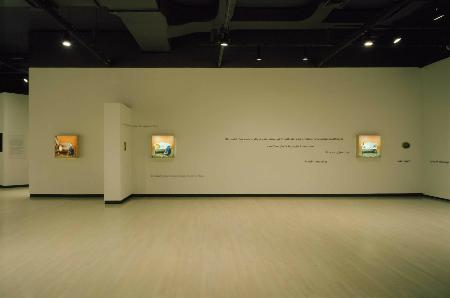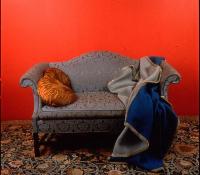Home »
Working Title »
The Essays »
What Are You Looking At?
1 2 3 4 5 6 7 8 < > «
What Are You Looking At?
Allyson Clay and Eliza Griffiths, Encounters with the Gaze
|
| Allyson Clay, Untitled I, II, III (1995-1998) installation view, Walter Phillips Gallery, 2002. Photo credit: Don Lee. |
In her exhibition
Imaginary Standard Distance at Mount Saint Vincent University Art Gallery (2002), Allyson Clay disrupts and subverts the traditional voyeuristic relationship of the male gaze. As
Luce Irigaray has observed1, the privilege of looking is generally male, and without physical contact to remind the viewer of the corporeal existence of the subject he scrutinizes, the body becomes an image. The eye is able to objectify and dominate more readily than other senses because it does so from the distance encouraged by perspectivalism’s positioning of the viewer outside the frame (
note2).
Allyson Clay,
Untitled I (My Sense of Place) detail, 1997.
In
Untitled I, II & III (1995-1998), an installation of three photographed self portraits mounted in light boxes accompanied by wall text and smaller framed images, Clay takes on the role of an odalisque, critiquing the male gaze inherent in much of modern painting. Each of the images depicts an ornate couch atop an oriental rug in front of a deep reddish-orange wall. This, as
Karen Henry notes3 in the exhibition catalogue, “... is reminiscent of
Olympia’s bed4 [in Manet’s painting of 1863] (and
Freud’s couch5), and the floral carpet implies an association with the
orientalism of Matisse.6”
Allyson Clay,
Untitled II (previously swallowed small artifacts)detail, 1997.
In one of the images, Clay lays in an almost fetal position on the settee, clothed, with her back to the viewer. This pose refers almost directly to Ingres’
The Grand Odalisque7 (1814). However, unlike the sensuous serpentine line of Ingres’ odalisque, Clay’s back is hidden in a loose dress and her gaze does not acknowledge the viewer. Clay, as Henry remarks, denies us access. She refuses to meet the viewer’s gaze and attempts to block visual domination through layers of clothing and by turning away. In another photograph Clay’s image is blurred as she leaves the frame.
Allyson Clay,
Untitled III (self portrait) detail, 1995-1998.
In the third, she is absent entirely. The ornate settee is exposed for what it is, a stage prop in the patriarchal theatre of modern painting. Our perception of an otherwise familiar relationship is put into question. Clay’s odalisque is active; she is a subject and as such extricates herself from this scene, signaling her refusal to be an object of desire and emphasizing her very presence behind the camera as artist/subject.
1 2 3 4 5 6 7 8 < Previous Next >
___________________________________
Endnotes
1. Luce Irigaray cited in Craig Owens, “The Discourse of Others: Feminists and Postmodernism,” in The Anti-Aesthetic: Essays on Postmodern Culture, ed. Hal Foster (Seattle: Bay Press, 1983), 70.
2. Rebecca Schneider, The Explicit Body in Performance (London and New York: Routledge, 1997).
3. Karen Henry, “Spatial Relations – Architectural Fragments,” Allyson Clay: Imaginary Standard Distance (Banff: Walter Philips Gallery Editions, 2002).
4. Edouard Manet's Olympia (http://www.jssgallery.org/Other_Artists/Manet/Olympia.htm). Last verified: 15 October 2005.
5. Freud’s couch (http://www.english.upenn.edu/~afilreis/freud-couch.html). Last verified: 15 October 2005.
6. oberlin.edu on Henri Matisse (http://www.oberlin.edu/allenart/collection/matisse_henri.html). Last verified: 15 October 2005.
7. Ingres’ The Grand Odalisque (http://web.archive.org/web/20010622064902/www.theartcanvas.com/ingres.godal14.htm). No longer online.
 Home Exhibitions MSVU Collection Publications Posters Working Title Resources
Home Exhibitions MSVU Collection Publications Posters Working Title Resources







